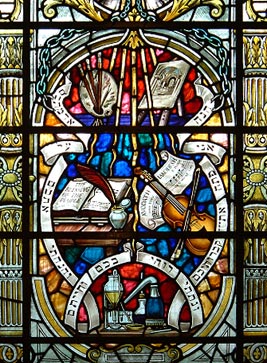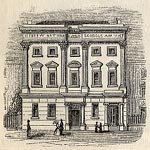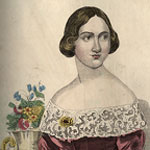
19th Century Birmingham Jewry
Conflicts
Integration
19th Century Birmingham Jewry
By the 19th century, Birmingham had become an important destination for migrants seeking to settle and find work in the labour intensive, heavily industrialised streets. Jewish settlers would join the town’s larger numbers of Irish Catholics (another target for social prejudice, brought here in great numbers after the Irish Potato Famine in the 1840s), as well as other numerous diverse enterprising merchants, and scatterings of refugees from slavery, famine and misfortune in Britain’s far flung colonial empires.
19th century Jewish marriage registers [JA/2/C] show a increasing community success story. Lists of Jewish occupations now include not only ‘hawkers’ and ‘commercial travellers’, but also tobacconists, watch and clock makers, confectioners, timber merchants, shoemakers, ironmongers, opticians, cap makers, coin factors and - perhaps most significantly - jewellers. Some of the community that had first settled around poor areas such as the Froggary, Hurst Street and Severn Street could begin to move into more prosperous areas like Edgbaston.
Meanwhile, second-generation Jews who could rightly claim to be born in Birmingham would now confront increasing numbers of new Jewish refugees. Many of these arrived from Eastern Europe and Russia, particularly after 1881, when Jews were blamed for the death of Tsar Alexander II, and forced into ghettos through further persecution. To escape threats on their life, many preferred to risk the hardship of a journey to London (home to large Jewish community), Liverpool, Manchester or Birmingham. Large numbers would pass on to America.
Alongside burdens of poverty and social prejudice that often remained, the new chapter in the story of the Birmingham Jewry was one of expansion, conflict and developments. Whilst a few 18th century Jewish settlers in Birmingham are known to have prospered (such as Mayor Oppenheimer, the innovative glassmaker), 19th century Birmingham would now feature a line of notable Jews who would lead the community to a position of greater (if still precarious) strength.
<return to top>
Conflicts
Across the 19th century, the Jewish community that had established itself for a number of generations in Birmingham faced many new and ongoing problems.
On the surface, it started to much more successfully support itself through a wide variety of trades, to educate itself though the building of new Jewish schools, and to integrate itself within the town’s ruling bodies and councils. But at the same time, the heavy competition of work, urban poverty, poor housing, religious discrimination and the ongoing influx of refugees in the late 19th century into Birmingham all presented a difficult challenge.
New settlers and the more established Jews would often be placed in a tense relationship with one another. The foreign refugees were often very poor, victims of atrocious religious persecutions which had uprooted them from their homes. They were very different in culture from the more ‘anglicised’ or ‘English’ Jews who had made their home in Birmingham for more than a hundred years.
There was often a painful struggle to reconcile these ‘new arrivals’, with their different speech, customs and appearance, to the more acceptably ‘civilised’ appearance of the more longstanding ‘English’ Jews of Birmingham. This inner conflict was also joined to the continuing set of barriers between Jew and non-Jew. At a national level, increasing social anxieties about immigration of refugees into Britain culminated in the 1905 Aliens Act, which now placed conditions on the number of refugees, including the Jews, entering England.
<return to top>
Integration
While poorer 19th century Jewish refugees in many cases remained perched in lodging houses or in the miles of ‘back to back’ housing that characterised Birmingham’s industrial landscape, the prospering section of the community had set about organising and integrating itself.
At this time, the growth of the community and the building of new synagogues had gone hand in hand with the creation of a Jewish Council, responsible for guiding the community and organising religious services. By the 1820s, the ‘Birmingham Hebrew Congregation’ was governed by a President and Vice President, plus a group of usually five men, known as ‘the Committee’. The archive minutes of this council are a vital resources for study into the newly ordered life of the community [JA/1/A].
A positive consequence arising from this Jewish Council would be a series of powerful personalities who gave voice not just to the ideals of Judaism, but also to the need for making new bonds with the rest of the town. Some key individuals were strong enough to speak out for their faith, to combat the prejudice against the Jewish community, and to encourage dialogues with other groups and communities.
Some 19th century Jews who had a strong impact included: the eloquent Dr. Rev M. J. Raphael, the first paid ‘lecturer’ of Hebrew community; the charismatic and powerful David Barnett, a business man, humanitarian, ‘president’ of the congregation and first Jew admitted on the city council; A. M. Blanckensee, also a council member, with connections to the Birmingham Board of Guardians and the General Hospital; and Jacob Jacobs, a humanitarian and prominent figure in Birmingham’s jewellery trade.
Notably, Jewish women were not allowed to take a public part on the council; and there are far fewer records of the lives of early female Jews in Birmingham. Nevertheless, it is certain that the women of the congregation would have been integral to the life of the synagogue and particularly fundamental to the Jewish charities that developed in the town. Sources through which we may glimpse their lives include Jewish Marriage registers [JA/2/C] and the Ladies Benevolent Board [MS 1678].
<return to top>
Author: Dr Andrew Green
Main image: Photograph by Brigitte Winsor
|
|

Education, Rights
and Resistance

Arts and Charities
|